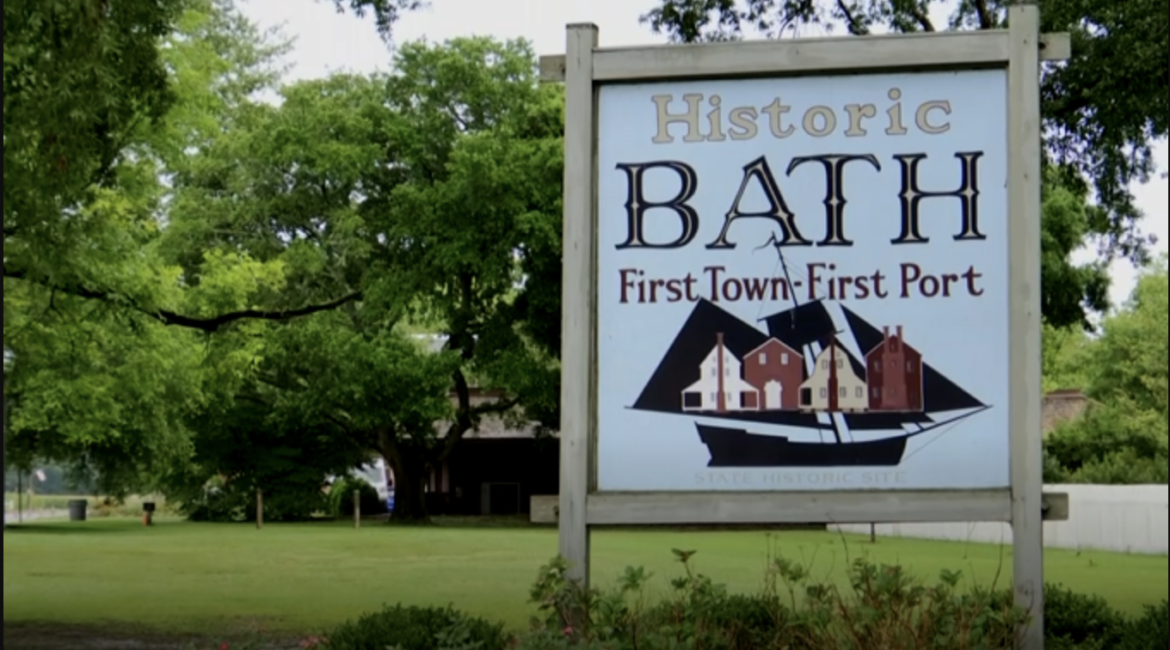

The Significance of Historic Bath
Historic Bath, N.C. played a significant role in shaping the early history of North Carolina. Not only was Bath the first incorporated town in 1705, the state’s first library (1701) and first church (1734) are located in Historic Bath. It was also the first working port, ships sailing across the Atlantic would stop in Bath to trade and resupply. Bath was named after the English city of Bath, England.
Besides these “firsts”, Bath was the site where the Tuscarora Indians attacked the settlers, initiating the bloodiest colonial war in North Carolina’s history.
Then around 1714 the notorious pirate Blackbeard showed up and decided to call Bath his home.
Despite this colourful past, in the late 1700’s Bath lost most of its importance and trade. But its history and preservation of historic sites makes it worth visiting. The Palmer-Mash House (1751), the Van Der Veer House (ca1790) and the Bonner House (ca1830) are open for tours. St. Thomas, the first church has an active parish and can be toured.
Where is Historic Bath, N.C.?
35.4771° N, 76.8116° W lies Bath, North Carolina. 50 miles off the Atlantic Ocean, Bath hugs the waterfront of the Pamlico River and nestles along Bath Creek. Views of this picturesque waterfront are abundant in Historic Bath.
Bath’s proximity to the open sea along with the mazes of inlets and hidden coves that make up North Carolina’s shore line made this area a perfect hideout for pirates looking to avoid the British Navy.
Colonial Bath | History of Town
Bath’s early history consisted of political rivalries, fever epidemics, Indian wars, and piracy.
The French Huguenots were the first settlers to Bath.They travelled from Virginia to North Carolina. Some of the early English inhabitants included John Lawson, Surveyor-General of North Carolina and Christopher Gale, Chief Justice of the colony. In the early 1700’s Thomas Cary was Governor. He was the main figure in the uprising known as Cary’s Rebellion.
The first public library in North Carolina was given to the St.Thomas Parish in 1701 by the Reverend Thomas Bray.
In 1707, a grist mill and colony’s first shipyard was established on the riverfront in Bath.
By 1708, Bath consisted of 12 houses and a population of 50 people. Trade in naval stores, furs, and tobacco was the foremost occupation.
In the summer of 1711, an outbreak of yellow fever took many lives, both Native Americans and settlers. Following this epidemic and without warning the powerful Tuscarora Indians launch war against the settlers. The Tuscarora War lasted until March 23,1713 when Colonel James Moore and his troops took Fort Nooherooka, a principal Tuscarora stronghold, freeing the Bath area from the threat of further Indian attack.
In 1718, Blackbeard the pirate ruled the seas and called Bath his home. With him came 20 other pirates that enjoyed this coastal town.
Then in the late 1700’s Bath lost most of its importance and trade when the County seat of government moved 12 miles up the Pamlico River to Little Washington.
Bath’s Most Famous Resident
It’s fair to say that the most notorious charter to call Bath his home was Edward Teach, more commonly known as Blackbeard, the pirate. Blackbeard arrived in Bath in June 1718, and was given the “gracious pardon” of the Royal Proclamation from colonial Governor Charles Eden.
It is believed that Blackbeard took up residence with his young wife in a home on Plum’s Point. According to Gerald Butler, site manager for Historic Bath,“it was a strategic point for Blackbeard. He could see what was going on in town and what was happening on the river.’
Blackbeard was killed on Nov 22,1718 in a battle with Lieutenant Robert Maynard. As a warning to other pirates his head was cut off and suspended from the bow of Maynard’s ship. It is believed that his headless body is buried somewhere on Ocracoke Island. His head has never been found.
Members of the Bonner family told of a ghostly phenomenon called “Blackbeard’s Lights.” During violent storms, they would see a ball of fire as large or larger than a man’s head sail back and forth from Plum Point to Archbell Point all night.
Historic Bath Today
Bath’s history lives on due to the locals and the preservation efforts dedicated to this historic town. And despite its wild history it remains relatively unchanged population-wise from its original incorporation over 300 years ago.
Whether you are planning a relaxing few days or a stop over on the way to the outer banks, Bath is a destination worth seeing.
As you stroll the streets of Bath you will pass historic homes and sites that pay tribute to the rich history filled with pirates, Indian wars and fierce political rivalries. If you happen to be there during an evening thunderstorm make your way to Bonners Pt to see if the fire ball is flying through the air.
To ensure a perfect visit plan on staying at the Inn on Bath Creek. It is conveniently located on historic Main St. There you will be welcomed with gracious hospitality and will wake to a mouth watering breakfast that will certainly get you off to the perfect day.
0 Comments